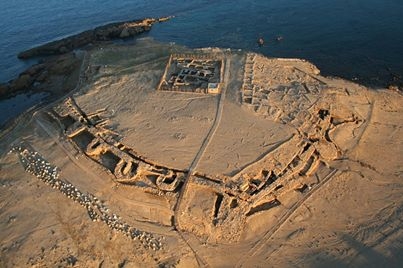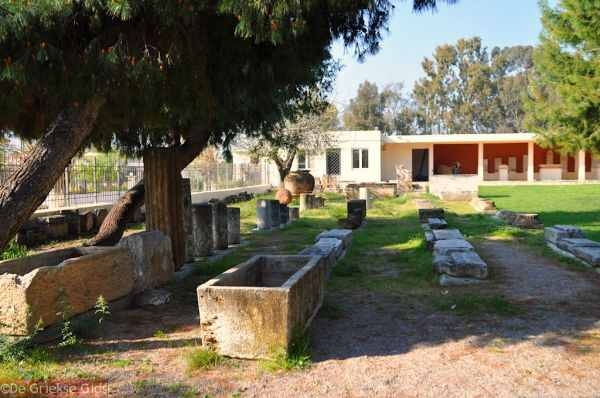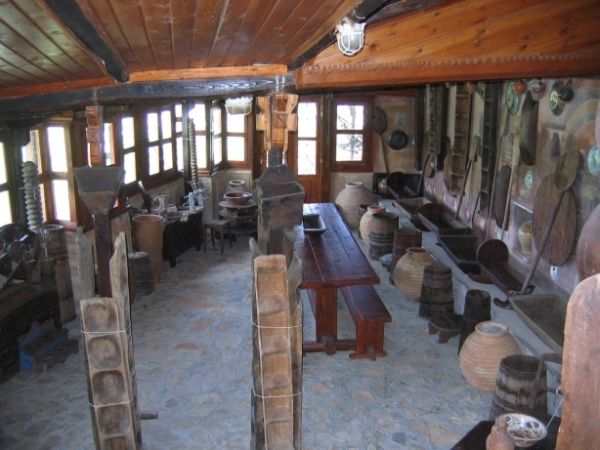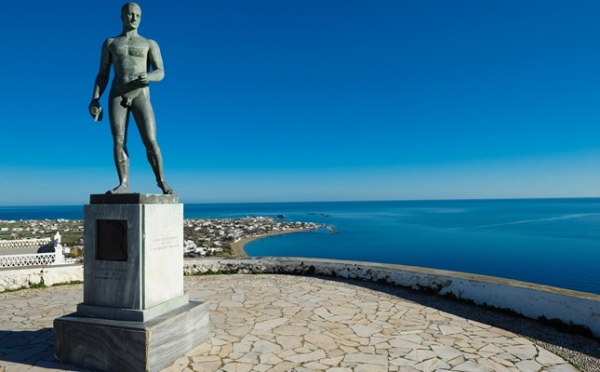
ARCHAEOLOGICAL SITE OF PALAMARI
At the bay of Palamari, which is located on the north side of Skyros, a fortified hamlet was discovered, and was dated to be from the Early and Middle Cooper Period (2500 – 1800 BC ).
This hamlet used to have a port that connected with the islands of the Cyclades, the east side of mainland Greece, and the North East Aegean sea.
Further research and work also led to the discovert of an organised city plan, with roads and impressive buildings. In some rooms of these building, stone seills, hearths, ovens and even formatted floors were discovered.
Other artifacts that were found here include a variety of vessels, stone tools and appliances, as well as tools made from bone, and a selection of metallic appliances. One very important finding was the wall with the large U-shaped bastions, which rose up in the uneven spaces.
From a defensive point of view, this hamlet was very well reinforced, with its front wall, trench and stone barrier. This type of fortification has Syrian and Palestine origins, which appeared in areas of the Aegean in approximately 2300 BC.

ARCHAEOLOGICAL MUSEUM OF SKYROS
The
two rooms of the Skyros Museum contain finds from archaeological
sites on the island dating from the Early Helladic period
(2.800-1.900 BC) to Roman times (1st c. AD).
Characteristic
vases in this case include a Cypriot-made flask, an Attic Geometric
pyxis with ponies worked in the round on the lid and the zoomorphic
rhyton (ritual vase) in the form of a horse.
Collections:
Pottery of the early Helladic period (2.800-1.900 BC) from
the city of Skyros, Palamari and elsewhere. The relief Cycladic lid
from Papalagoudi, and the Trojan goblet from Palamari are of some
importance. The case also contains paint-boxes and obsidian tools.
Pottery of Mycenaean period (1.600-1.100 BC) from various
sites on the island: askoi, stirrup jars, alabastra, skyphoi, etc.
Two vases, one with a scene of a ship and the other with fishes, are
of special interest.
Pottery of the Protogeometric period
(11th-9th c. BC) from the cemetery on the coast at Magazia. The
skyphoi, pitchers, single-handled tall glasses, fine oinochoai,
miniature trefoil pots, and the jewellery, such as the gold leaves
and hair-rings, and faience necklaces, are typical of the wealth of
this period.
Finds from the Protogeometric and Geometric
periods (900-800 BC). The krater with the motif of the wheel (case 4)
is of interest, as are the bronze bracelets (case 4), the local
coarseware vases (case 5), and the Protogeometric plate no. 353 (case
5).
Protogeometric and Geometric pottery from Magazia and
Themi. The annular vase with birds, and the pyxis of Attic-Cycladic
type on the bottom shelf (no. 184) are of particular interest.
Mainly Protogeometric pottery from Agia Anna and Magazia: a
flask, a gold hair ring and earrings, two puppets, bronze bracelets
and a series of fine vases: jugs, wheel-made cups, a hydria etc.
Finds of the Geometric and Archaic periods from recent
excavations: Euboean ?made Corinthian aryballoi, Geometric pictures
with scenes of horses, superb, richly decorated skyphoi, an electrum
(alloy of gold and silver) band, brooches and necklaces, and imported
faience vases.
Vases and other objects from the Classical to
the Roman period (5th - 1st c. BC): a female statuette of the
classical period, a Hellenistic head and a statuette of a child,
Hellenistic pottery, a plastic, zoomorphic vase, and the headlees
statuette of Cybele.
The following sculptures are of
interest: an archaic Kore, grave stele, which was recut on the back
in Roman times, a fragment of a head of a core, and a statue,
possible of Apollo. In the courtyard are displayed architectural
members and the sculptures of various periods, and the Protogeometric
and Geometric Sarcophagi.
http://odysseus.culture.gr/h/1/gh151.jsp?obj_id=3502contact number +30 2222 0 91327

FALTAITS MUSEUM
Established in 1964, the Faltaits Museum was one of the first local historical folk art museums. It embraces the history and the culture of Skyros from the post Byzantine period to the present day. It was created in a move to preserve the traditional Skyrian inheritance and also to make the point to the rest of Greece, that tradition had a part to play in both the present and the future.
Housed in the residence of the "Faldai" family, the museum dominates the north-east edge of the town on the site where an ancient temple uses to be. It stands in the biggest tower, known locally as "Paleopyrgos", on the very ancient Pelasgian walls of Skyros.
www.faltaits.gr Contact Number +30 2222091232 - 2222091150

RUPERT BROOKE
In the bight of Tris Boukes, which is a safe refuge from the violent north winds and a few meters from the beach, a person could visit the grave of the English poet Rupert Brooke (1887-1915) who died and was buried there, at his wish, in the 23-4-1915 at the age of 28 when he was serving in the English Navy during the First World War.
There is a bronze statue of Rupert Brooke, on the north-east side of the village, near the archaeological museum and the small church of Agia Triada (Saint Trinity), in a very beautiful and prestigious site - a square.
The main statue is a symbol of the eternal, undying poetry and there are the following inscriptions on the both sides - east and west - of it:
"This monument was put up in 1930 due to international money collections - and now that I saw the Holy Land of Attica, I may die - Rupert Brooke".
There is an embossed bust of the poet as well as the following dedication on the west side of the statue's base:
"To Rupert Brooke, 1887-1915, and his eternal, undying poetry".
The entire piece of art was made by the sculptor M. Tombros who is said to have had Alexandros Iolas, a young, handsome up-and-coming dancer, as a model.
The unveiling ceremony of the memorial took place in 5-4-1931 by the then Prime Minister, Eleftherios Venizelos, in the presence of Greek and foreign personalities.
(It's an extract of the book entitled "The island of Skyros" written by Napoleon Xanthoulis).

George Lambrou was born in Skyros 1946. Studied at the Athens School of Fine Arts in sculpture studio of Yannis Pappas. He graduated in 1969. Honored with the first two commendations for nude Nightlight and three commendations sculpture.
The painting began with the theme of the Bible and in sculpture with Wire sculptures. Works at the Ministry of Culture, the City of Athens, Thessaloniki, Skyros, Argiroupolis, the National Gallery, the Benaki Museum which was an exhibition on 40 years of sculpture in 2010, the Museum of Contemporary Art in Andros Museum Vorres in Paiania in Rethymnon ¨ L. Kanakakis ¨, the Cultural Foundation of the National Bank, the National Bank, the Bank of Greece, in Collections Emfietzoglou Copelouzos and in private collections in Greece and abroad. For the artistic creation of George Lambrou have written many Greeks critics.
At his home in Magazia of Skyros, running an art space with paintings and sculpture next to the hotel Perigiali. Available posters paintings, drawings and cards on Skyros.
In the same area there are also books of his sister Aliki Lambrou, Skyrian costumes, catalog sculpture - painting, songs and customs of Skyros with music pentagram and Byzantine notation.
Opening hours: 11:00 to 13:00 & 19:00 to 22:00 Tel +30 22220 91334
| Title / Name | Info |
|---|---|
Archaeological Palamari |
| Title / Name | Info |
|---|---|
MANOS FALTAITS MUSEUM | +30 22220 91232 |
| Title / Name | Info |
|---|---|
Brooke's Statue | |
Archaeological Museum of Skyros | +30 22220 91327 |